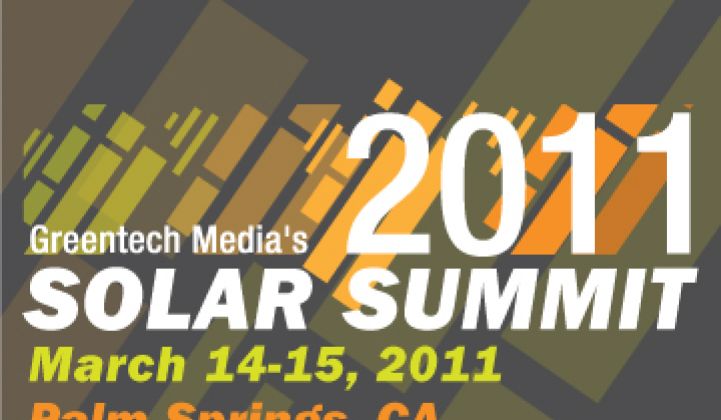Indian Wells, Calif.---In most businesses, competitors tend to soften their comments about one another.
That’s the not the case in inverters and solar electronics.
“I don’t get it,” said Raghu Belur, co-founder of microinverter maker Enphase Energy, when asked about companies that want to popularize DC maximizers for improving how centralized inverters work during an interview at the Solar Industry Summit this week. “I simply don’t get it.”
Companies that specialize in central inverters like SMA and microinverter specialists like SolarBridge and Enphase are locked in a battle over the future of solar electronics. Microinverter champions say that their technology works better and costs less in any type of solar installation of any size, anywhere in the world.
Enphase has a pending third-generation product, for instance, that achieves efficiencies in the 96-percent-plus range and will be capable of being installed at utility-scale sites. The company is also looking at advanced AC-DC materials like gallium nitride, a material promoted by Transphorm, and more silicon carbine.
In a few years, a microinverter could consist of three components and need very little copper and other raw materials, Belur speculated. This will allow the industry to ride the Moore’s Law cost curve down. Dick Swanson, the keynote speaker at the event, said that the SunShot program sponsored by the Department of Energy seeks to get solar down to $1 a watt installed: in that scenario, only ten cents could be allocated to inverters.
Centralized inverter advocates, meanwhile, argue that they too are driving down costs and looking at advanced materials. Some of the efficiencies obtained through microinverters with things like DC maximizers. Most centralized inverter makers (including SMA) have actually laid plans to make microinverters, but they generally believe that microinverters will largely be confined to the residential market.
More importantly, central inverter advocates say that microinverters create risk. Instead of having a centralized box, microinverters force solar installers to put 20 to 30 times the number of devices into the field, which means more potential points of failure.
“If reliability is compromised, it will hurt the entire industry,” said Jurgen Krenkhe, president and general manager of SMA America.
Ken Christensen of central inverter maker Advanced Energy added that central inverters hit efficiencies in the 97-percent-plus range.
Luckily, as interviews and panel discussions proved, the two sides aren’t afraid to air their differences.
“There is this idea that centralized inverters are more reliable, but the data doesn’t support that,” said John Berdner, general manager of North America for SolarEdge during a panel discussion. “This idea is simply not true.”
Berdner cited a study from SunEdison that showed that central inverters exhibited a reliability of under 50 percent, while string and microinverters were 95 percent reliable. Part of the problem stems from how these products are made. Microinverters are produced on manufacturing lines, while centralized inverters are largely hand-assembled.
“Reliability” in the study referred to the number of times a service call was made and did not necessarily account for every actual breakdown. And speaking of data, Krenkhe added that microinverters have only been in volume production for about two years.
“To look at six, nine or twelve months of data is a snapshot,” he said.
That comment prompted Barry Cinnamon, CEO of Westinghouse Solar, to pop open his laptop and show me data. (Cinnamon wasn’t on the panel. He just happened to be sitting next to me in the audience.)
Over a two-year period, Westinghouse/Akeena Solar installed 10,630 microinverters, of which 22 had to be replaced. The company also installed 3,373 centralized inverters; 318 had to be repaired. The microinverter-powered systems lost 528 hours of power production. The central inverter systems lost 464,000 hours. (Side note: Cinnamon noted at SMA had the far lowest failure rate.)
The disparity in hours of power production lost comes because in a centralized inverter system, the entire solar array goes down if the inverter does. In a microinverter system, only individual panels are temporarily off-line.
In response, Jeff Krisa, vice president of sales and marketing at Tigo Energy, which makes DC maximizers that link to centralized inverters, noted that a lot of residential installers like microinverters. DC maximizers are just beginning to be introduced.
Who’s right? The data over the next few years will tell the tale. Microinverters are definitely gaining ground -- Enphase claims a 13 percent market share in recent California residential installations. The company also gives a 15-year warranty and claims its microinverters will last far longer. Still, the products are only a few years old and the solar industry is notoriously conservative.
One company to watch, later in the fall, will be Canadian Solar, the fast-growing module maker. Alan King, vice president of sales, said the company will unfurl an all-in-one module/electronics offering in the fall. (Canadian CEO Shawn Wu has more on electronics in this interview.)
The key difference? The module will have a 25-year warranty, and the electronics will also have a 25-year warranty. SolarBridge offers a 25 year warranty. Fancy that!
Stay tuned.



